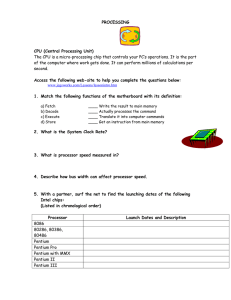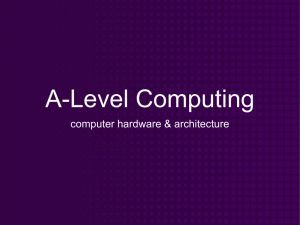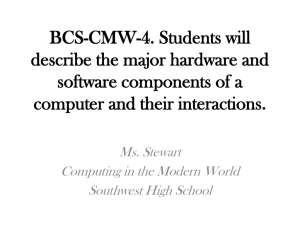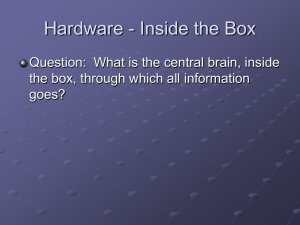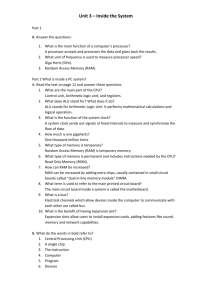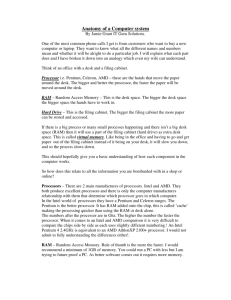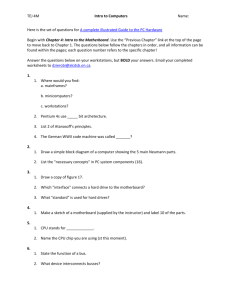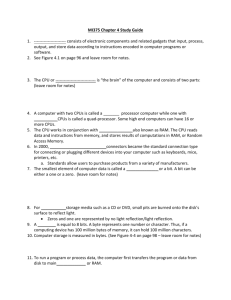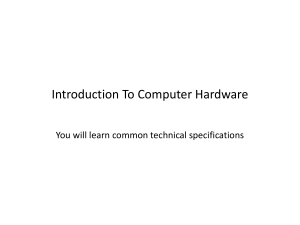hardware_inside_03f
advertisement
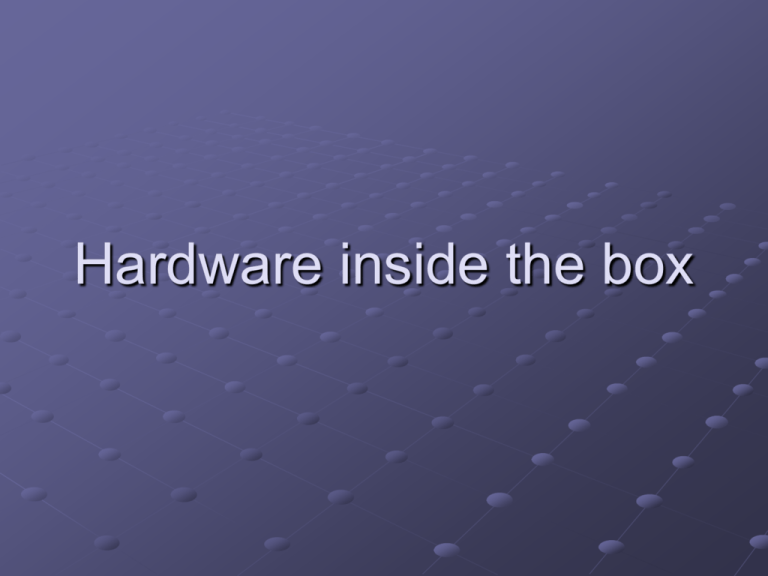
Hardware inside the box Announcement Invited talk today at C106 from 7:00PM Required Movie at C106 Pirates of Silicon Valley Starring Noah Wyle (ER) and Anthony Michael Hall (Sixteen Candles) Two times: Tuesday Sept 9th, 7-9 pm Wednesday Sept 10th, 7-9 pm Cast of Characters Apple Microsoft Steve Jobs Steve Wozniak (beard) Bill Gates (Huge glasses) Paul Allen (beard) Steve Ballmer (bald) Today’s Information Microprocessors (CPU) Memory Motherboards Storage Metric System Kilo = Mega = Giga = Tera = These terms are used frequently to describe storage and speed in computers Metric System Kilo = 1000 Mega = 1,000,000 = 1 million Giga = 1,000,000,000 = 1 billion Tera = 1,000,000,000,000 = 1 trillion These terms are used frequently to describe storage and speed in computers Basic storage unit 1 bit : Single 1 or 0 is a bit. 1 Byte = 8 bits = eight 1s or 0s in any combination 10100011 “B” represents byte and “b” represents bit. (KB and Kb are different units.) 1 KB = Kilobyte = 1024 Bytes (210) 1 MB = Megabyte = 1024 Kilobytes = 220 Bytes 1 GB = Gigabyte =1024 Megabytes = 230 Bytes (1073741824 Bytes) Where are my Bytes? If you have bought a memory card or hard drive, computer will report that it is smaller than what you paid for. Manufacturers are playing tricks here. 512MB(metric) = 512*106 Bytes/(10242) = 488.3MB(reported by computer), that is 4.6% difference 40G(metric)=40*109 Bytes/(10243)=37.3G (reported by computer ) you lose 6.9% Two things determine function Processor Speed This is the speed at which information is processed RAM (Random Access Memory) This is how much information is available for rapid processing Computer Speed Hz = Hertz = Cycles/second MHz = Megahertz = Million cycles/second GHz = Gigahertz = Billion cycles/second Typical processor today runs at 2 GHz! If numeric addition takes 4 cycles, that is 500 million additions in a second. Moores Law Manufacturers always coming out with faster processors It takes about 18 month the fastest processors to double in speed 1996 – 233 MHz 1998 – 450 MHz 2000 – 1.4 GHz (cost $600 in 2000, $100 today) 2002 – 3.06 GHz and more! Take Home Message: Don’t buy the top of the line processor, it will be dated very quickly! 8088 Evolution of Intel Microprocessors and Pursuit by AMD Processors 80286 80386 AMD 386 80486 AMD 486 Pentium Pentium Pro AMD K5 AMD K6 Pentium II AMD K6-II Pentium III AMD K6-III Celeron (Castrated Pentiums) Pentium IV Duron Athlon Important Microprocessor Qualities Speed, e.g. 1.5 GHz (Gigahertz) Level 2 Cache - speeds processing Memory inside the CPU. It is much faster than the main memory. A huge chunk of computer programs are loops. So moving these loops into cache can speed up the processing. The major difference between Pentium and Celeron series CPU are amount of cache. Memory - RAM RAM is Random Access Memory CPU can not access to the Hard drive directly. Program needs to be moved into RAM first. RAM is memory that is “volatile.” when you shut down the computer, everything in RAM is gone. RAM stores info and data of running programs Types of RAM DDR Ram is Double Data Rate, for Athlon and Pentium IV SDRAM – Used in a lot of machines, but being phased out RIMMS – Newest and fastest For Pentium IV, 400 MHz transfer rate Adding new RAM is the cheapest and easiest way to make your computer run faster Analogy If the processor is the brain of the computer, then what is the motherboard? The Spinal Cord Processor and Motherboard make up Central Neural System Motherboards Circuitry that connects all items to the processor Card slots for modems, sound cards, graphics cards Socket or slot for processor Bus speed determines processors Motherboard must be compatible to CPU Motherboards and Microprocessors Motherboard must have appropriate socket or slot for processor Motherboard must support processor’s speed and have the same bus speed Storage Media Media refers to the objects on which information is stored Singular of word is medium A CD is a medium for storage, a floppy disk is a medium, … Storage: Magnetic “Drive” Storage: magnetic polarity stores 1s and 0s Hard Drives - Internal, sealed platters Floppy Drive - One flexible platter Zip Drive – Very high capacity floppy Storage: Solid State Memory Solid state is contrast to the moving parts of HD, Floppy Disk… Digital memory Compact Flash Smart Media Multi-Media card (MMC) and Secure Digital card (SD) USB drives. Storage: Optical Read Only CD-ROM – 650MB or 700 MB, read only, etched pits drives 32X etc. for speed relative to normal DVD - stands for Digital Video Disc, 4.7 Gb (7X CD) single side, single layer. 4x DVD does not mean it is slower than a 16x CD-ROM. CD Burners – Optical Read/Write CD RW 32x/8x/40x means 32x maximum write speed, 8x max. rewrite speed, and 40x max. read speed Media: CD-R is cheapest, write once CD-RW – good medium for transporting files New Generation: DVD RW There are two competitive standards of DVD RW, respectively DVD+RW and DVD-RW. Media for these two type are NOT interchangeable. Will both of them survive in 5 years? Best strategy: DVD-/+RW Technically, can I duplicate my own DVD movies? Assignment for Next Week Measure computer startup speed Find out processor speed, type Amount of RAM Operating System Startup computer three times, measure in seconds Go to course website for more info and form
